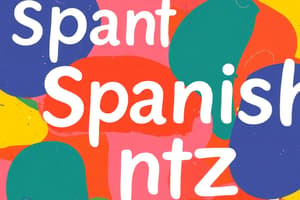Podcast
Questions and Answers
Which of the following countries has Spanish as a native language?
Which of the following countries has Spanish as a native language?
Spanish does not use gendered nouns.
Spanish does not use gendered nouns.
False
What is the typical sentence structure used in Spanish?
What is the typical sentence structure used in Spanish?
Subject-Verb-Object
Many Spanish words originate from ______, reflecting historical influences.
Many Spanish words originate from ______, reflecting historical influences.
Signup and view all the answers
Match the following key figures in Spanish literature with their contributions:
Match the following key figures in Spanish literature with their contributions:
Signup and view all the answers
Which of the following is a feature of Spanish dialects?
Which of the following is a feature of Spanish dialects?
Signup and view all the answers
Spanish has no variations in its vocabulary and grammar depending on the region.
Spanish has no variations in its vocabulary and grammar depending on the region.
Signup and view all the answers
Spanish verbs conjugate based on the ______, number, and tense.
Spanish verbs conjugate based on the ______, number, and tense.
Signup and view all the answers
Study Notes
Spanish Language Overview
- Spanish is a Romance language, originating from Vulgar Latin spoken in the Iberian Peninsula.
- It's the native language of a vast population across numerous countries, including Spain, Mexico, Colombia, Argentina, and many others.
- Spanish is significant globally for its prominence in diverse areas like literature, music, and film.
- Its vocabulary and grammar have developed through centuries of evolution and interaction with other languages.
- The language's variations across different regions lead to distinct accents and colloquial expressions.
Spanish Grammar
- Spanish follows a subject-verb-object (SVO) sentence structure in many cases.
- The language utilizes gendered nouns (masculine or feminine) and articles that agree with the nouns' gender.
- Verbs conjugate based on person, number, and tense.
- Noun plurals typically follow specific patterns to indicate plurality.
- Spanish employs various tenses to convey aspects of time, such as present, past, and future.
- A system of pronouns is used to clarify the subject or the object of action, avoiding ambiguity.
- Prepositions play a vital role in structuring sentences and conveying meaning in specific contexts.
Spanish Vocabulary
- Spanish vocabulary is heavily influenced by Latin, which forms the foundation of many words.
- Many words originate from Arabic, reflecting historical cultural exchange.
- Loanwords from other languages, particularly French and English, have added to the vocabulary.
- Idioms and expressions are prevalent, adding depth and cultural nuances to the language.
- The vocabulary demonstrates a diversity of concepts and cultural references.
Spanish Dialects
- Spanish exhibits considerable regional variation in pronunciation, vocabulary, and grammar.
- Distinct accents are evident geographically.
- Differences in vocabulary are often related to cultural specificities or regional variations.
- Colloquialisms, differing from formal language, vary significantly across regions.
- Idioms and expressions reflect cultural variations.
- Differences in pronunciation and sentence structure are key features distinguishing dialects.
Spanish Literature
- Spanish literature has a rich history, showing development and cultural influences for centuries.
- Key authors, like Cervantes, have contributed significantly to the literary canon.
- A diverse range of genres are represented, from poetry to novels, plays, and essays.
- Literary movements, such as the Golden Age in Spain, have impacted the development of the language and style.
- The evolution of Spanish literature mirrors broader historical and social trends.
- The literary scene demonstrates distinct Spanish characteristics.
Spanish Culture and Communication
- Spanish is linked to countless cultural traditions.
- The language is used in daily contexts across various spheres of life, including education, commerce, and relationships.
- Understanding nuances and social context is essential for effective communication.
- Gestures, body language, and customs directly affect how people interact and use the language.
- Proper etiquette and social cues need consideration during interactions.
Studying That Suits You
Use AI to generate personalized quizzes and flashcards to suit your learning preferences.
Description
Explore the fundamentals of the Spanish language, including its evolution from Vulgar Latin and its global significance. This quiz covers essential aspects of Spanish grammar, such as sentence structure, gendered nouns, and verb conjugations, providing a comprehensive overview for learners.




